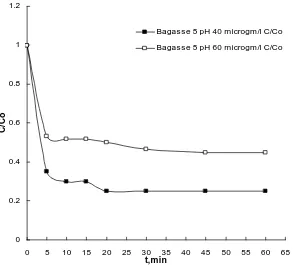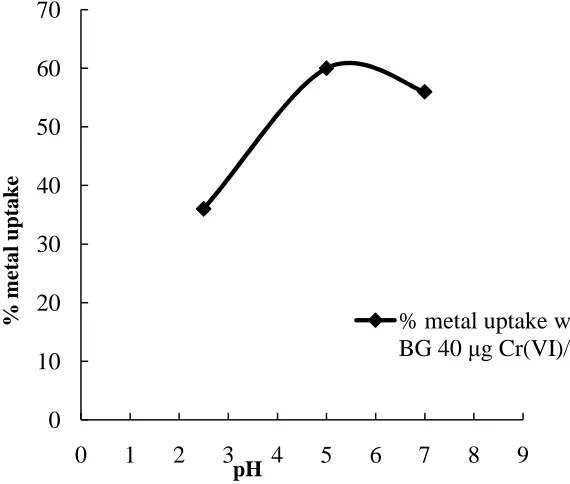Biosorption Studies for Chromium (VI) Removal Using
Sweetlime Fruit Skin & Bagasse
Neetu Divya, Bidyut Mazumdar
Department of Chemical Engineering, National Institute of Technology, Raipur, 492010, Chattishgarh, INDIA E Mail: neetudivya@gmail.com
ABSTRACT: Heavy metals are released into the environment from a wide range of natural and anthropogenic sources. As a result, there has been a great deal of attention given to effective and low cost technologies for removal of heavy metal ions from polluted water. Biosorption is one such emerging technology which utilized naturally occurring waste materials to remove heavy metals from different sources. The aim of the present study was to utilize the locally available agricultural waste as biosorbent for heavy metal removal from wastewater. The potential to remove Cr (VI) from aqueous solutions through biosorption using low-cost adsorbent such as sweetlime fruit skin (SLFS) & bagasse (BG) was investigated in batch experiments. The concentration and pH were the parameters used. Change in pH had appreciable effect on the adsorption of Cr (VI). The adsorption process for the removal of Cr (VI) is more efficient in acidic medium for both adsorbents. SLFS gives better adsorption capacity at 2.5 pH and baggase (BG) gives at 5 pH. The experiments were conducted for various concentration of Cr(VI) and it was found the percentage removal efficiency was high with 40 µg/l Cr(VI) solution.
Keywords: Biosorption, Low-cost biosorbent, Sweetlime fruit skins (SLFS), Bagasse (BG)
1. INTRODUCTION
The research on the utilization of agricultural waste as adsorbent for the removal of heavy metals from the aqueous solution has become an interesting field for researchers. The agricultural wastes are available at low-cost. They are capable of binding to heavy metals by adsorption. discharged into natural water from various industries including textile industries, electroplating, leather tanning and metal finishing industries. Once chromium is introduced into the environment it exists in two stable oxidation states, Cr (III) and Cr (VI). The trivalent form is relatively innocuous, but hexavalent chromium is toxic, carcinogenic and mutagenic in nature, highly mobile in soil and aquatic system and also is a strong oxidant capable of being surface water is 0.1 mg/l and in potable water is 0.05 mg/l. But the concentration of Cr (VI) in the industrial
wastewater ranges from 0.5 to 270.000 mg/l.2Dara agricultural waste ,Sargassum sp.,activated carbons prepared from agricultural wastes ,Chitosan coated oil plam shell charcoal ,kendu fruit gum dust ,london plane leaves , rice husk ,conifewrous leaves, coconut husk and palm pressed fibers,bengal gram husk have been reported in the literature.4,5,6,7,8,9,10,11,12,13 Many other biomaterials were used for the adsorption of other heavy metals.
In this study, sweet lime fruit skin (SLFS), bagasse (BG) agricultural wastes are used as biosorbents to remove Cr (VI) from aqueous solution. Study was carried out using pH and concentration as parameters.
2. MATERIALS AND METHODS
2.1. Pretreatment of biosorbents
medium 3000) and then screened through Tyler screen to obtain the particular size (8/10 mesh size) of biomass.
2.2. Preparation of stock solution
Chromium stock solution was prepared by dissolving K2Cr2O7 in distilled water. 1.414 g of K2Cr2O7 was dissolved in 1000 ml of distilled water.14 pH of the solution was adjusted using 0.2 N H2SO4.
2.3. Biosorption Experiments
The batch experiments were conducted in 250 ml borosil beakers containing 100 ml of Cr (VI) solution of desired concentration (i.e. 40, 60 µg Cr (VI) /l). For investigation of effect of pH the experiments are repeated at different pH such as 2.5, 5, 7. The samples were shaken continuously at room temperature with 5 g/l of each adsorbent (SLFS, BG, 8/10 mesh size). The solutions were withdrawn at different time intervals and filtered through a 41 Whatman filter paper. From the filtered solution 10 ml sample was pipette out and diluted up to 100 ml, the initial pH of the sample was adjusted 1.0 ± 0.3 using 0.2 N H2SO4, well mixed then 2.0 ml 1,5-diphenylcarbazide solution was added and kept for 10 min for full color development. After the coloration an appropriate volume has taken in absorption cell and its absorbance was measured at 540 nm (using microprocessor photo colorimeter 1312 ELICO). The remaining concentration of Cr (VI) in the sample was determined. The above procedure was repeated for different sets of experiments.
2.4. Analytical methods
Absorbance was measured at 540 nm using microprocessor photo colorimeter 1312 ELICO. The amount of Cr (VI) adsorbed in µg/g at time ‘t’ was biosorbent (g) and the amount of metal uptake at time t (µg Cr (VI)/g) respectively.
The percentage removal (% R) of Cr (VI) ions from aqueous solution was calculated by;
% R = [(Co-Ct)/Co] x 100
(2)
3. RESULTS AND DISCUSSION
3.1. Effect of Cr (VI) concentration
i.e. 40 µg/l Cr (VI) solution in comparison of 60 µ g/l Cr (VI) solution [Figure.1]. The percentage removal of Cr (VI) was 65% with SLFS at 2.5 pH. Similarly with BG biosorbent the percentage removal of Cr (VI) was 75% at 5 pH [Figure.2]. Graph shows that the rate of biosorption is a function of the initial concentration of metal ions. This happens due to the increase in the number of ions competing for the available binding sites in the biosorbent and also due to the lack of binding sites for the complexation of Cr ions at higher concentration levels. At lower concentrations, all metal ions present in the solution would interact with the binding sites and thus facilitated higher biosorption. At higher concentrations, more Cr ions are left unabsorbed in solution due to the saturation of binding sites of biosorbent.13Therefore, the concentration of metal ions is a significant factor to be considered for effective biosorption.
3.2. Effect of pH
To study the effect of pH, three different pH of Cr (VI) solution was adjusted i.e. 2.5, 5 and 7 pH. The effect was investigated for both concentrations i.e. 40 µg/l and 60 µg/l of Cr (VI) solution. The Cr (VI) removal was observed with different pH of Cr (VI) solution with two biosorbents i.e. ‘SLFS’ and ‘BG’ for 60 min biosorption process. It was observed that the 2.5 pH was optimum pH for SLFS and 5 pH for BG. Result shows that the biosorption process for the removal of Cr (VI) is more efficient in acidic medium for both biosorbents (Figure.3 and Figure.4). The reason for this is, the pH of the aqueous phase is lowered, a large number of hydrogen ions can easily coordinate with the amino and carboxyl groups present on the biomaterial surface. Thus, a low pH makes the biomaterial surface more positive.15
3.3. Effect of adsorbent
The concentration of both the Cr (VI) metal ions and the biosorbent is a significant factor for effective biosorption. The rate of adsorption is a function of the initial concentration of ions.
The effect of biosorbent on the removal of Cr (VI) solution. It was found that BG gives efficient removal of Cr (VI) at 5 pH and it is 75% [Figure.5].
biosorption capacity for Cr (VI) removal from aqueous solution. The removal is pH dependent. Both biosorbent works efficiently in acidic medium. The efficiency of SLFS was fairly high at 2.5 pH whereas with BG at 5 pH.Biosorption is fast with low concentration of initial Cr (VI) solution. It was found that BG shows efficient capacity to remove Cr (VI) in comparison to SLFS. Bagasse (BG) gives 75 % removal of Cr (VI) instead of 65% with SLFS biosorbent. Further study is required for more clarification such as characterization of biosorbent and kinetics.
5. REFERENCES
1. Bishnoi, N.R., M. Bajaj, N. Sharma and A. Gupta. Adsorption of Cr (VI) on activated rice husk carbon and activated alumina. Bioresour.
Technol.91,(2004) 305-307.
2. Patterson, K.E., Coltheart, M., Marshall, J. C. Surface dyslexia. Lawrence Erlbaum Associates. Hillsdale. NJ(1985)..
3. Dara S. S. Text book of engineering chemistry. S. Chand & company publication(2004)..
4. Krishnani, K.K., Parimala, V., & Meng, M. Detoxification of Cr (VI) in coastal water using lignocellulosic agricultural waste. Water research. ISSN 0378-4738. 30(4),(2004)
541-545.
5. Amorim, R.V.S., Melo, E.S., Carneiro-da-Cunha, M.G., Ledingham, W.M., & Takos-Takaki, G.M. Chitosan from Syncephalastrumracemosum used as a film support.for lipase immobilization.
Bioresource Technology.89, (2003) 35-39.
6. Demirbas, E., Kobya, M., Senturk, E., &Ozkan, T. Adsorption kinetics for the removal of chromium (VI) from aqueous solutions on the activated carbon prepared from agricultural waste. Water SA. 30(4), (2004) 533-539.
7. Saifuddin M., Nomanb H., Kumaran P. Removal of heavy metals from industrial waste watwater
using chitosan coated oil palm shell charcoal.
Electronic journal of Biotechnology, 8(1), (2005)
20-30.
8. Samantaroy, S., Mohanty, A. K. &Misra M., Removal of hexavalent chromium by Kendu fruit gum dust. Journal of Applied Polymer Science,66(8), (1998) 1485-1494.
9. Masakazu A. Removal of Cr (VI) from aqueous solution by London plane leaves. Journal of
Chemical Technology and Biotechnology,78(5),
(2003)601–604.
10. El-Shafey, E. I. Behaviour of reduction-sorption of chromium (VI) from an aqueous solution on a modified sorbent from rice husk. Water, Air, and
Soil Pollution, 163(1–4), (2005)81–102. pressed fibers. Environmental (Letters) ETLEDB,
14(3), (1993) 277-282.
13. Ahalya, N., Kanamadi, R.D., & Ramachandra, T.V. Biosorption of chromium (VI) from aqueous solutions by the husk by Bengle gram (Cicerarientinum). Electronic journal of biotechnology,8(3), (2005)258-264.
14. APHA (American public health association). (19thedn). Standard methods for the examination of water and wastewater. Washington D.C. (1985) 3-60.
15. Park, D., Seong-Rin L., Yeoung-Sang, Y., & Jong, M. Reliable evidences that the removal mechanism of hexavalent chromium by natural biomaterials is adsorption-coupled reduction.
Figure 1. Effect of different concentration at 2.5 pH with SLFS biosorbent
0 0.2 0.4 0.6 0.8 1 1.2
0 10 20 30 40 50 60 70
t,min
C
/C
o
SLFS 2.5 pH 40 microgm/l C/Co
SLFS 2.5 pH 60 microgm/l C/Co
0 0.2 0.4 0.6 0.8 1 1.2
0 5 10 15 20 25 30 35 40 45 50 55 60 65 t,min
C
/C
o
Bagasse 5 pH 40 microgm/l C/Co
Figure 3. Effect of different pH with SLFS biosorbent
Figure 4. Effect of different pH with BG biosorbent
0
5
10
15
20
25
30
35
40
45
50
0
1
2
3
4
5
6
7
8
9
% metal uptake with SLFS
40
µ
g Cr(VI)/l
%
m
et
al
u
p
tak
e
pH
0
10
20
30
40
50
60
70
0
1
2
3
4
5
6
7
8
9
% metal uptake with
BG 40
µ
g Cr(VI)/l
%
m
et
al
u
p
tak
e
Figure 5. Percentage Cr (VI) Removal efficiency of biosorbent for SLFS and BG
%
R
Biosorbents
Figure 5. Percentage Cr (VI) Removal efficiency of biosorbent for SLFS and BG
SLFS
Biosorbents


